The breakfast cereal sector – which is expected to grow at a CAGR of 4.2% during 2022-2028 to $57.5m, according to Insight Partners – has been much in the news of late, thanks to both its advocates and its opponents.
Right off the bat, WK Kellogg CEO Gary Pilnick managed to nab the headlines with what I suspect was a heartfelt suggestion, but one that quickly backlashed into a media furore.
Pilnick’s views also open the avenue to analyze the cost of a bowl of cereal today vs a year ago. And thirdly, I delve into reports that voluntary fortification of vitamin B by the breakfast cereal sector – while done in good faith – could have ominous repercussions.
Them vs us

Pilnick’s supposed ‘off-the-cuff’ comment has opened a can of worms.
“The cereal category has always been quite affordable and it tends to be a great destination when consumers are under pressure,” Pilnick told CNBC’s Squawk on the Street during a discussion about grocery prices that have billowed by 28% over the past four years.
“If you think about the cost of cereal for a family versus what they might otherwise do, that’s going to be much more affordable."
CNBC host Carl Quintanilla asked the WK Kellogg CEO whether his remarks could "land the wrong way", but Pilnick insisted that “cereal for dinner is something that is probably more on trend now, and we would expect [it] to continue as that consumer is under pressure.”
As a millionaire and purportedly beyond the pain of inflation, the media was quick to coin Pilnick’s quote as ‘let them eat flakes’ (think Kellogg’s Frosted Flakes).
The remark plays into the 18th Century scenario when Marie Antoinette – in response to the fact that her people had no bread – intoned ‘Qu’ils mangent de la brioche’ (roughly translating into ‘let them eat cake’).
At a recent Florida industry conference, PepsiCo CEO Ramon Laguarta similarly encouraged the exploration of culinary uses for the snacking giant’s Doritos and Rold Gold pretzels – suggesting them as ‘side dishes and ingredients’ to meals. His remarks, surprisingly, have for the most part fallen below the radar. Again, the punt was to boost sales: PepsiCo Frito-Lay North America also saw a 2% in volume for the fourth quarter.
With cake being far more expensive than bread, the anecdote was an example of the wife of King Louis’ ivory-tower obliviousness to the arduous daily life of ordinary people. Pilnick’s supposedly nonchalant remark, too, was picked up by the media to denote an insensitivity or incomprehensiveness of the realities of life for those less unfortunate than him.
Obviously, the CEO was looking to promote breakfast cereals into other mealtimes, which is not surprising as WK Kellogg’s fourth-quarter sales – despite price increases – saw volumes dip by 10%. It was not the first time the Battle Creek-headquartered company had punted cereal for dinner either. However, the August 2022 initiative – #KelloggsCerealforDinnerEntry – didn’t receive any backlash, so Pilchnick evidently thought he was in safe waters.
While the above scenario demonstrates that everyone – be it food manufacturer or consumer – is struggling, the food industry remains tarnished with the avaricious brush. From shrinkflation to greedflation, these are today’s buzzwords that have left the consumer with a bitter taste. It’s even become official. Collins English Dictionary defines 'greedflation' as the use of inflation as an excuse to raise prices to artificially high levels in order to increase corporate profits.
How cereal prices have changed over the past 12 months
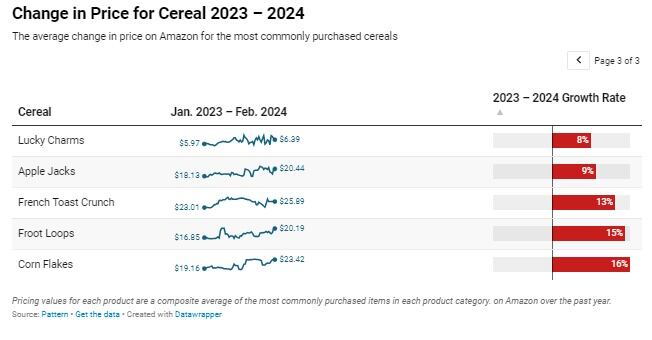
E-commerce accelerator Pattern has taken a deep dive into what Americans can expect to pay for their bowl of cereal.
According to the US Bureau of Labor Statistics, prices of food products (in general) is up 2.6%, with cereals and bakery products up 1.5% year-over-year. Surprisingly though, Pattern found several of the most popular cereals have experienced ‘inflation reversal’.
The site identified America’s most popular and then analyzed Amazon daily data between January 2023 and February 2024.
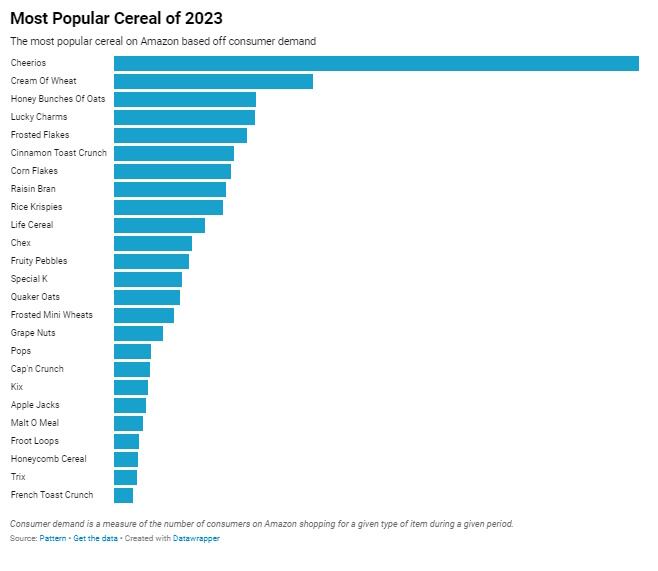
Half of the brands experienced inflation reversal year-over-year, while the other half saw price spikes that were more than the national average inflation:
- Rice Krispies: decreased in price by 6%
- Cheerios: -4%
- Cinnamon Toast Crunch: -4%
- Honey Bunches of Oats: -4%
- Life Cereal: -2%
- Cream of Wheat: +4%
- Raisin Bran: +5%
- Frosted Flakes: +7%
- Lucky Charms: +8%
- Corn Flakes: +16%
According to Pattern, when looking at the cereal landscape holistically, more cereals experienced inflation reversal than those that didn’t. Here are some that saw the sharpest reduction in price year-over-year:
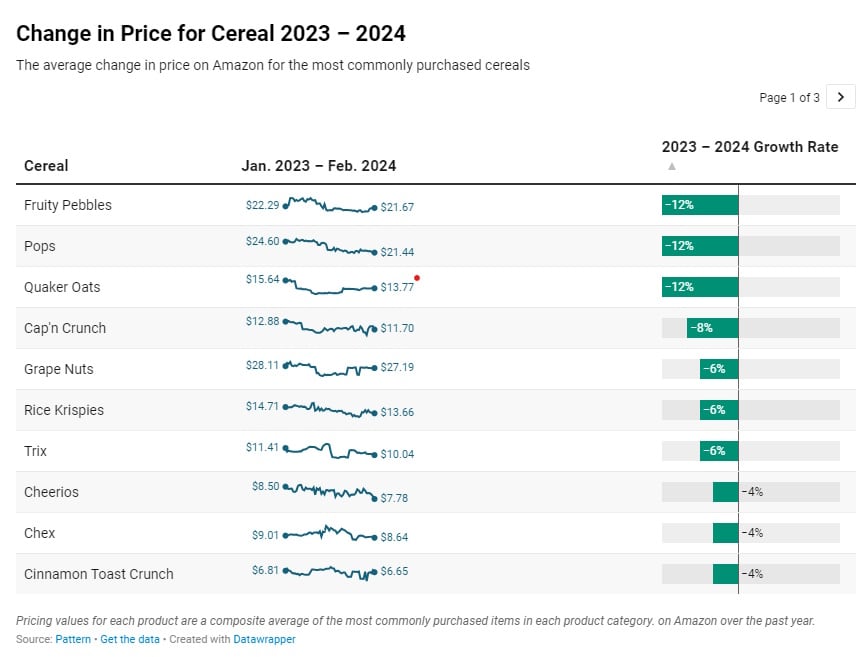
Health warning
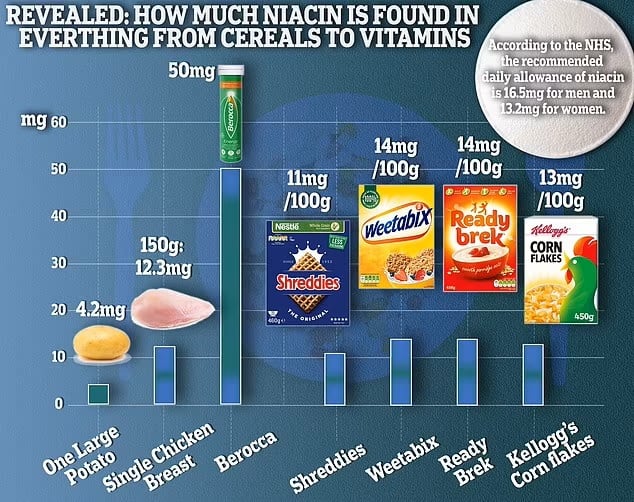
The breakfast cereal sector is also dealing with heat from the scientific sector, which now contends the voluntarily fortification of niacin is not as beneficial as it was first perceived to be.
Niacin (vitamin B3) helps improve circulation and has been shown to suppress inflammation. It was also recommended to lower cholesterol.
Adding to the woes
A January 2024 study by the Environmental Working Group found 90% of Americans tested had chlormequat - used by the agricultural industry to optimize yield and harvest - in their systems. Just as troubling, the health watchdog detected it in 92% of oat-based foods purchased in May 2023, including Quaker Oats and Cheerios.
Although no human trials have to-date been conducted, a slew of research has found adverse effects – even at extremely low levels – in animals raised on chlormaquat-treated grains, from fertility problems (in both males and females) to adverse effects on embryos and postnatal health.
Read How much chlormequat does your breakfast cereal contain?
“For decades, the United States and more than 50 nations have mandated niacin fortification in staple foods such as flour, cereals and oats to prevent diseases related to nutritional deficiency,” said Dr Stanley Hazen, who led the Cleveland Clinic study.
In a complete turnaround, the researchers now warn that too much niacin is strongly associated with cardiac conditions.
Dr Hazen compares the intake of niacin as multiple taps filling a bucket with water. Too much and it begins to spill over. In dealing with that spill-over, the body produces metabolites, including one called 4PY (N1-methyl-4-pyridone-3-carboxamide).
Another study – published in Nature Medicine – found high levels of 4PY are strongly associated with development of heart attack, stroke and other cardiac events. High levels of 4PY was found to only arise when the body breaks down excess niacin.
“Niacin’s effects have always been somewhat of a paradox,” said Dr Hazen.
“Despite lowering cholesterol, the clinical benefits have always been less than anticipated. This led to the idea that excess niacin caused unclear adverse effects that partially counteracted the benefits of cholesterol-lowering.”
The authors believe their findings suggest that it may be time to reconsider the mandatory fortification of niacin.
“There is no doubt that mandated fortification has been one of the best public health programs and was an amazing success,” said Dr Hazen, adding there have been no recent US cases of pellagra, a potentially deadly condition caused by niacin deficiency.
“The main takeaway is not that we should cut out our entire intake of niacin,” he added, rather advising “a discussion over whether a continued mandate of flour and cereal fortification with niacin could be warranted.”
Some of the breakfast cereals fortified with niacin:
- Ralston Enriched Bran Flakes 26.3mg/serving (164% DV)
- Kellogg (product 19 multi-vitamin & mineral cereal): 20mg/serving (125% DV)
- Cheerios Multigrain: 20mg/serving (125% DV)
- Weetabix: 14mg/serving (88% DV)
- Kellogg’s Frosted Flakes: 10.3mg/serving (65% DV)
- Mom Brands’ Sweetened Popped-Up Corn Cereal: 10mg/serving (63% DV)
- Cream Of Wheat: 10mg/serving (63% DV)
- Post - Big Real Honey Sweetened Corn & Oat Cereal: 9mg/serving (56% DV)
How to start your day
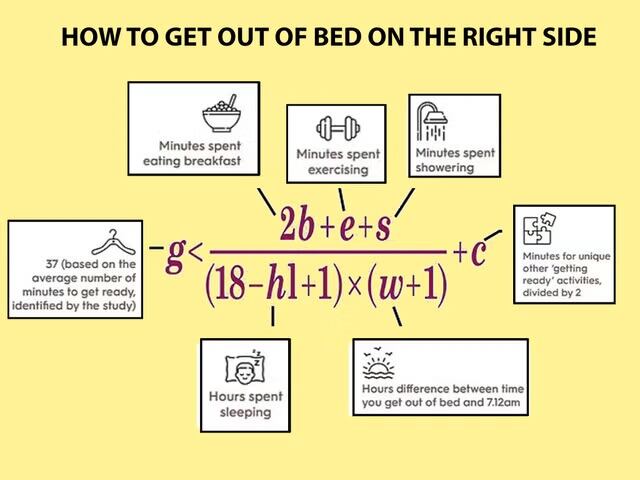
A Kellogg’s Special K-backed scientific review has devised the perfect start to your day.
- Double the time you spend eating breakfast.
- Add the number of minutes you spend exercising and showering.
- Subtract the total number of hours you slept the night before from the optimum 8-hour recommendation.
- Work out the difference in hours between when you get out of bed and 7:12am.
- Divide the time spent eating, showering and working out by the sleeping and getting up times.
- Add together the number of minutes spent doing other morning activities like getting ready or completing a crossword.
- Divide that number by two to arrive at a numerical value – that number, in minutes, corresponds to the ideal length of time you should be spending on your morning routine.
This then should make the formula for the ‘perfect start’ to your day
Studies:
Cleveland Clinic. Link between high levels of niacin - a common B vitamin - and heart disease, study suggests. ScienceDaily, 19 February 2024.
Ferrell, MW, Anderson, JT, et al. A terminal metabolite of niacin promotes vascular inflammation and contributes to cardiovascular disease risk. Nat Med 30, 424-434 (2024). doi.org/10.1038/s41591-023-02793-8


